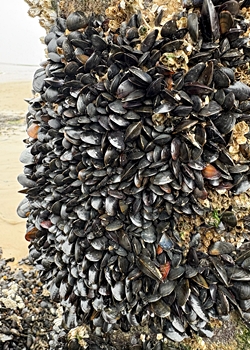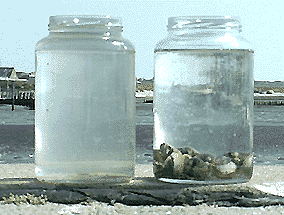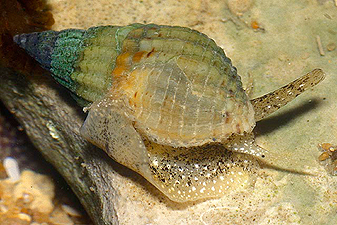| Diese Seite auf Deutsch! |
|
Common or Blue MusselMytilus edulis Linnaeus, 1758 |
 Blue mussel bank in Zeeland, Netherlands. Photo: Maaike Verschueren (iNaturalist). |
Class: Bivalvia
![]() Subclass:
Autobranchia
Subclass:
Autobranchia
![]()
![]() Infraclass: Pteriomorphia
Infraclass: Pteriomorphia
![]()
![]() Order: Mytilida
Order: Mytilida
![]()
![]() Superfamily: Mytiloidea
Superfamily: Mytiloidea
![]()
![]() Family: Mytilidae
Family: Mytilidae
![]()
![]() Mytilus edulis Linnaeus, 1758
Mytilus edulis Linnaeus, 1758
Source: MolluscaBase eds. (2025): Mytilus edulis Linnaeus, 1758.
 Blue mussels overgrown with barnacles. Photo: Keith Hiscock, Marine Life Network. |
 Inhalant (left) and exhalant (centre) siphons of a living mus- sel. In the right part of the picture the mussel's foot can be seen. Source: Tiere der Ostsee: Die Miesmuschel. |
From the soft body of the mussel, one usually sees only the strong foot protruding from between the shells. At its end is the byssus gland, which produces the byssus thread - a tough, protein-based fibre that is one of the secrets of the mussel’s success. Using these byssus threads, mussels can attach themselves not only to the substrate and to each other, but also move about by laying out a thread and then contracting it, thereby pulling the shell forward.
Besides the foot, the two siphons can be seen when the mussel opens its shells wide enough. Mussels do this only under water, when they breathe and feed.
Experiment
with Blue Mussels Harbour water from Juist is filled in two glasses. In the right one, a handful of mussels are placed. The left glass is used as comparison. |
|
 After an hour, the mussels have filtered the water, so it becomes transparent. Source: Aldebaran (1997). |
But what happens to the suspended particles that the mussel filters from the seawater? From the respiratory current, the mussel separates digestible particles and directs them to its digestive tract, while indigestible material is expelled through the exhalant siphon. As a result, a layer of mud accumulates around the mussel - composed of fine particles that once floated in the seawater.
The common mussel (Mytilus edulis) was originally restricted to the coastal waters of the eastern North Atlantic, from about Aquitaine northwards to Norway, the White Sea and Spitsbergen. In the western North Atlantic it occurs from Washington, D.C. to about Maine. From Nova Scotia northwards it is replaced by the Pacific mussel (Mytilus trossulus). In contrast, the common mussel has also been recorded in southern Greenland and Iceland. Through accidental transport and deliberate introduction in aquaculture, it is now also found in parts of the North Pacific. In the Mediterranean, the Mediterranean mussel (Mytilus galloprovincialis) occurs instead. As the individual Mytilus species are very closely related and can hybridise with one another, they are often referred to collectively as the Mytilus edulis complex.
Typical habitats extend from the high-tide line downwards along rocky coasts to the vicinity of river mouths, where the mussels often form dense beds together with barnacles. Mussels are also found in the Baltic Sea, but due to the lower salinity they reach only a comparatively small size of up to five centimetres, while their relatives in the North Sea can grow to about twice that size and develop stronger shells.
Their preferred habitat is in the intertidal and shallow subtidal zones, down to depths of around 20 metres, where they attach themselves to solid substrates by means of byssus threads. These threads are produced by a gland at the base of the foot. By anchoring themselves, mussels protect against being washed away and can even pull themselves free from the mud that accumulates around them as a result of their own filtering activity. They are able to detach their byssus threads and move short distances with the help of the foot before reattaching. Mussels require summer water temperatures of at least 4 °C. In mussel beds, they may form very dense populations of up to 2,000 individuals per square metre.
Like their feeding, the reproduction of mussels also depends on the surrounding water. Mussels are dioecious, meaning there are separate males and females. In spring and several times during summer, each female mussel releases about 5 to 12 million eggs into the water, where they are fertilised by sperm cells from nearby males. This can result in a concentration of roughly one mussel larva per millilitre of seawater!
 Veliger larva of Mytilus galloprovincialis. Source: Ferrara University, Italy. |
Until they reach about 5 cm in length, young mussels may still change location several times. They then attach permanently to a suitable substrate, preferably close to other mussels. Millions of individuals connected by their byssus threads form the well-known mussel beds. The advantage is obvious: by living in dense aggregations, the chances that sperm released by a male will encounter eggs from another mussel and fertilise them are greatly increased.
Even after settling, mussels are exposed to numerous predators from both the water and the air. Above the surface, gulls and oystercatchers are among their enemies; underwater, eider ducks, starfish and crabs prey on mussels.
A major mussel predator is the common whelk (Buccinum undatum). This largest predatory snail of the North Sea lies in wait in front of a mussel, waiting until it must open its shells to breathe. Then it inserts its siphon and proboscis between the shell halves and begins to devour the now defenceless mussel.
 Netted dog whelk (Hinia reticulata). Picture: Eric Walravens. |
In addition to these biotic factors, abiotic factors also play an important role in the life and survival of mussels. Mussel beds that fall dry at low tide can be planed off and destroyed by drifting ice in winter. On the other hand, those exposed mussel beds - slowly raised above sea level by the accumulation of sediment resulting from the mussels’ own filtration activity - are safe from underwater predators such as whelks and starfish. The most favourable position for mussel beds is slightly above the low-water line. Such beds remain exposed for about four hours per tide - long enough to force starfish and snails to retreat.
 Respiration and nutrition of a common mussel (Mytilus edulis). Source: Aquascope. |
The scientific name Mytilus goes back to the Greek philosopher Aristotle. "Μυτίλος" (mytilos) already referred to an edible mussel in ancient Greece. The Latin epithet edulis further emphasises the fact that mussels are edible - and very tasty indeed. Mussel fishing has been practised along the German coast in Lower Saxony and Schleswig-Holstein for more than a hundred years. In addition to the traditional harvesting of natural mussel beds (which locally have become quite rare), artificial mussel beds have been established in sheltered areas since the 1930s. These cultivated beds are less exposed to predators and thus produce larger mussels, which are ready for harvest after at least one year.
In Europe, the leading countries in mussel farming are the Netherlands and Denmark, with around 100,000 tonnes of mussels per year, compared to about 20,000 tonnes from the German federal states of Schleswig-Holstein and 8,000 tonnes from Lower Saxony.
Latest Change: 05.11.2025 (Robert Nordsieck).